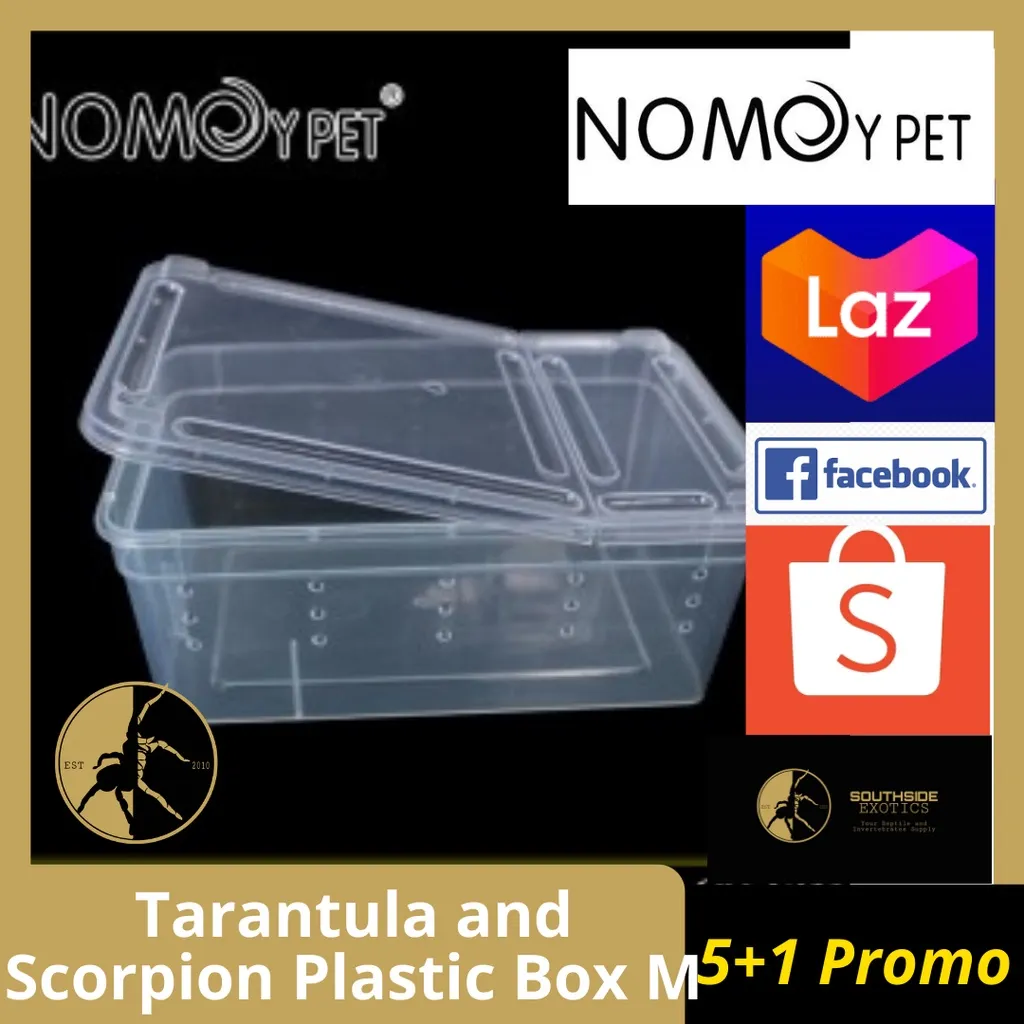What is a Tarantula Enclosure
A tarantula enclosure, also known as a terrarium or habitat, is a specifically designed environment to house and care for your tarantula. It’s more than just a container; it’s a carefully constructed space that mimics the tarantula’s natural habitat, providing everything it needs to thrive. This includes adequate space for movement, appropriate substrate for burrowing or climbing, proper ventilation to maintain air quality, and a secure lid to prevent escapes. Choosing the right enclosure is crucial for the tarantula’s physical and psychological well-being, as it significantly impacts its health, behavior, and overall lifespan. The enclosure provides the tarantula with a sense of security, allowing it to exhibit natural behaviors such as hunting, hiding, and molting. Selecting the appropriate enclosure is an essential step in responsible tarantula ownership.
Why is the Right Enclosure Important
The right enclosure is paramount to the health and happiness of your tarantula. A poorly chosen enclosure can lead to a host of problems, from physical injury and stress to respiratory issues and even premature death. An undersized enclosure restricts the tarantula’s movement and can lead to a lack of exercise, potentially causing obesity and other health complications. Inadequate ventilation can trap harmful gases and create a humid environment that fosters the growth of mold and bacteria, endangering your pet’s respiratory system. Moreover, the enclosure’s design directly influences the tarantula’s ability to regulate its body temperature and humidity, crucial factors in its survival. A suitable enclosure provides a safe and enriching environment that allows the tarantula to express its natural behaviors, contributing to its overall well-being. It is the foundation of proper tarantula care.
Size Matters for Tarantulas
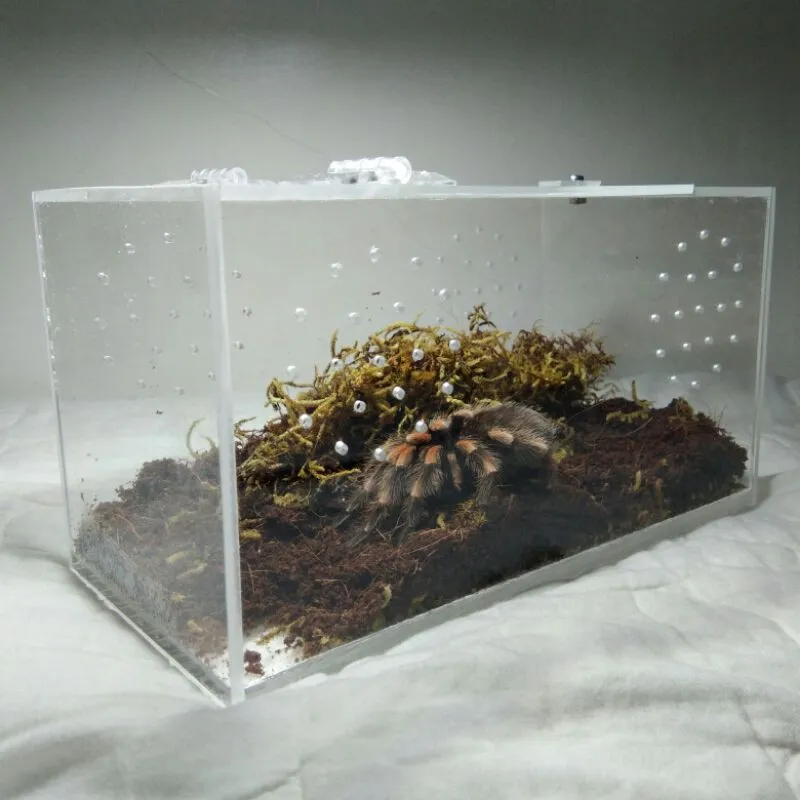
One of the most critical factors when selecting a tarantula enclosure is its size. The size of the enclosure directly impacts the tarantula’s ability to move, hunt, and exhibit natural behaviors. An enclosure that is too small can be incredibly stressful for the tarantula, leading to a variety of problems. These problems can include a decreased appetite, a reluctance to move, and an increased likelihood of the tarantula bumping into the sides of the enclosure, which can damage its delicate legs and other body parts. Moreover, an undersized enclosure can make it difficult to maintain the correct temperature and humidity levels, essential for the tarantula’s health. Conversely, an enclosure that is too large can also present challenges, making it difficult for the tarantula to find food and feel secure. Therefore, the appropriate size of the enclosure is a fundamental aspect of responsible tarantula care.
How to Determine the Right Size
Determining the appropriate size for your tarantula’s enclosure involves considering several factors. A general guideline is that the enclosure should be at least twice the tarantula’s leg span in width and length, and the height should be at least equal to the tarantula’s leg span, especially for arboreal species. This allows the tarantula ample space to move around, hunt, and establish its territory. Consider the tarantula’s species, as some species are more active and require more space than others. Also, factor in the adult size of your tarantula, as you’ll need to accommodate its growth over time. When in doubt, it’s generally better to err on the side of a slightly larger enclosure, provided you can maintain appropriate environmental conditions. Remember to account for the space occupied by substrate, water dishes, and any decorations you plan to include in the enclosure. This will ensure your tarantula has plenty of room.
Substrate and Ventilation Needs
The substrate is the material that forms the floor of your tarantula’s enclosure and serves several vital functions. It provides a surface for the tarantula to walk on, burrow in (for terrestrial species), and it helps to maintain humidity levels within the enclosure. The choice of substrate depends on the tarantula’s species and its natural habitat. Popular choices include coconut fiber, peat moss, and a mixture of soil and sand. Ensure the substrate is deep enough for the tarantula to burrow if it’s a species that does so. Ventilation is equally critical. Proper ventilation allows for air circulation within the enclosure, preventing the buildup of harmful gases and the growth of mold. The enclosure should have ventilation holes, usually near the top and sides, to allow for adequate airflow. The number and size of these holes depend on the size of the enclosure and the humidity needs of the tarantula species. Always balance ventilation with humidity requirements to create the ideal living environment.
Different Enclosure Materials
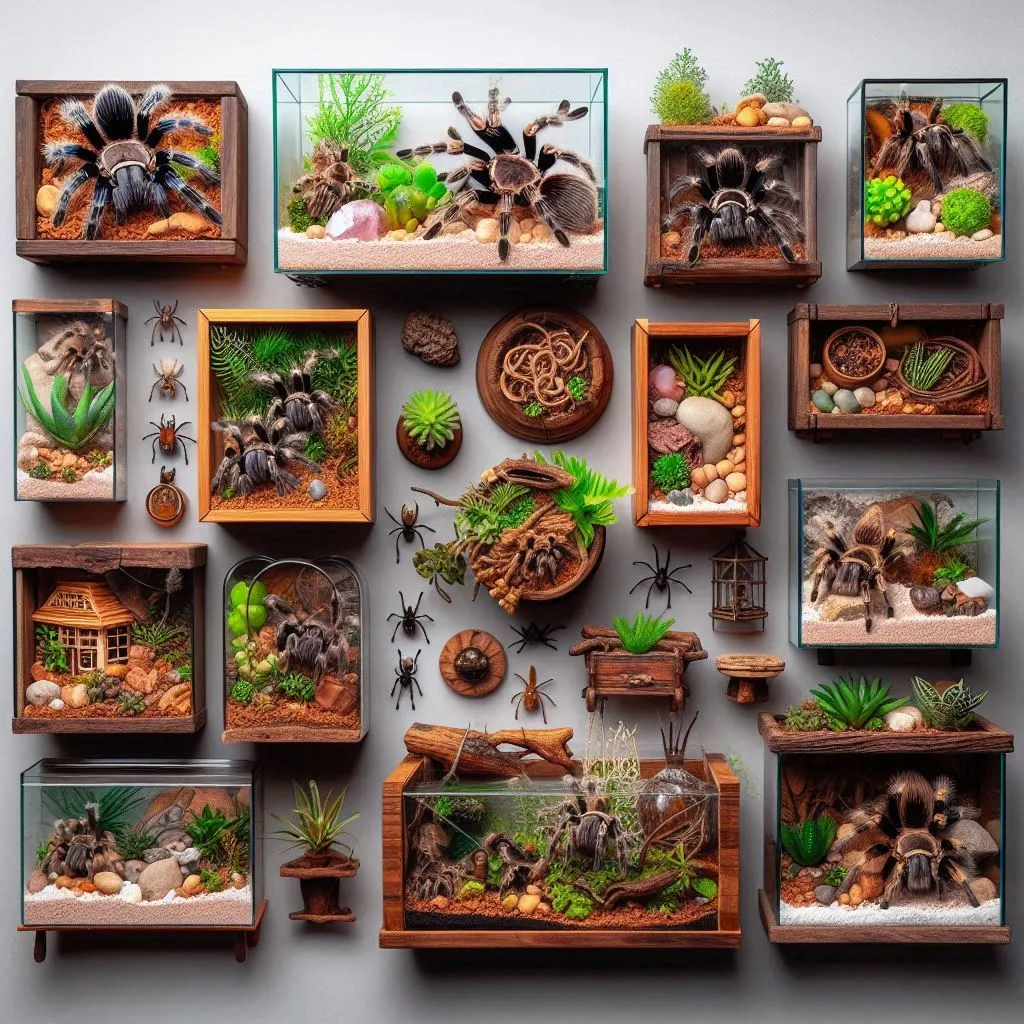
Tarantula enclosures are available in a variety of materials, each with its own advantages and disadvantages. The most common materials are glass, acrylic, and plastic. The choice of material often comes down to personal preference, budget, and the specific needs of your tarantula species. Each material affects the enclosure’s aesthetics, durability, and ease of use, playing a vital role in the overall care and maintenance of your pet. Consider which aspects are most important to you, taking into account the long-term maintenance and the overall safety of your tarantula. Careful consideration of these factors is crucial when deciding which enclosure material best suits your needs and provides the optimal habitat for your tarantula. Making the right choice will contribute to a healthier and more enjoyable experience for both you and your arachnid companion.
Glass Terrariums
Glass terrariums are a popular choice for tarantula enclosures due to their aesthetic appeal and durability. They offer excellent visibility, allowing you to easily observe your tarantula. Glass is also relatively easy to clean and maintain, making it a practical choice for tarantula keepers. However, glass terrariums can be heavy and fragile, and they may not retain heat and humidity as well as other materials. They also tend to be more expensive than plastic containers. Ensure the glass is thick enough to withstand accidental impacts and the lid is secure to prevent escapes. Look for features like pre-drilled ventilation holes. Glass terrariums are a good option for those who want a clear view of their tarantula and are willing to invest a little more in their enclosure.
Acrylic Enclosures
Acrylic enclosures offer several advantages over glass, including being lighter, more durable, and better at retaining heat and humidity. They also provide excellent visibility, similar to glass. Acrylic is less likely to shatter than glass, making it a safer option. However, acrylic can be more prone to scratches and may cloud over time if not properly maintained. They are usually more expensive than glass and plastic enclosures. Make sure the acrylic enclosure has adequate ventilation and a secure lid to prevent escapes. Acrylic enclosures are an excellent choice for tarantula keepers who prioritize durability, insulation, and ease of handling, making them a popular option, particularly for those with arboreal species that require higher humidity levels.
Plastic Containers
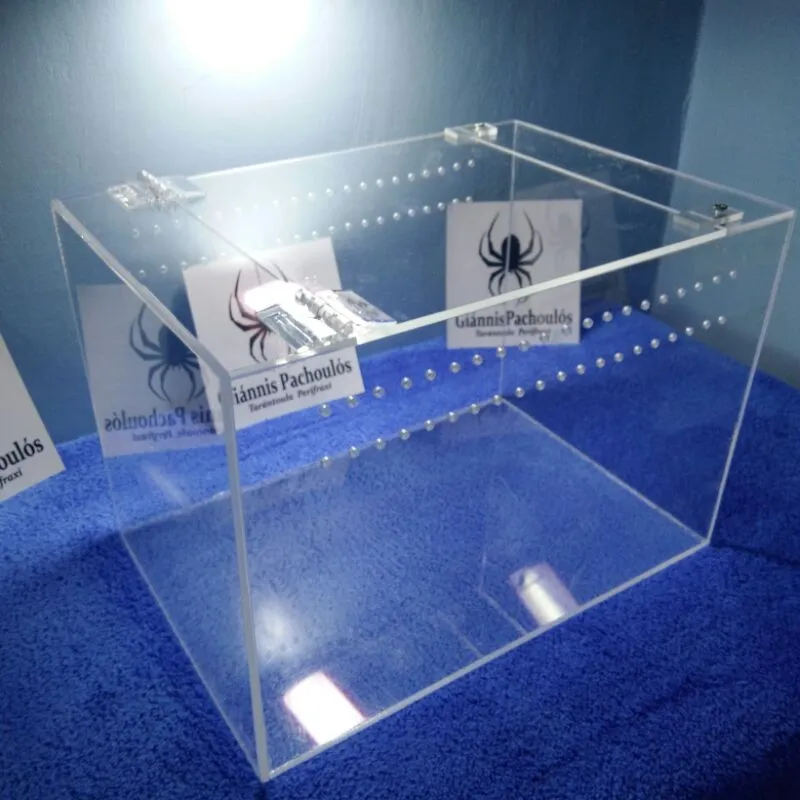
Plastic containers are the most budget-friendly option for tarantula enclosures, and they come in a wide variety of sizes and shapes. They are lightweight, easy to clean, and readily available. However, plastic containers may not be as aesthetically pleasing as glass or acrylic, and their visibility may be limited. Make sure the plastic is food-grade and non-toxic to the tarantula. Ensure that the container has secure ventilation and a lid that is designed to prevent escapes. For beginner tarantula keepers or those on a budget, plastic containers can be a practical and cost-effective option. They can also be easily modified to suit specific needs, making them a versatile choice for various tarantula species.
Top Features to Look for
When selecting a tarantula enclosure, several key features can make the difference between a good habitat and a great one. Prioritize features that will ensure the safety and well-being of your tarantula and make it easier for you to provide proper care. By paying attention to these essential elements, you can create an environment that fosters a healthy and happy life for your arachnid friend. These are critical aspects of responsible tarantula ownership, contributing to a rewarding experience for both the keeper and the tarantula.
Ventilation Requirements
Adequate ventilation is crucial for maintaining the health of your tarantula. Proper airflow prevents the buildup of harmful gases and helps regulate humidity levels within the enclosure. Look for enclosures with well-placed ventilation holes, typically located near the top and sides. The size and number of these holes should be appropriate for the size of the enclosure and the specific humidity needs of the tarantula species you are housing. Excessive humidity, without proper ventilation, can lead to mold and fungal growth, which can be detrimental to your tarantula’s health. Ensure that the ventilation system allows for good air circulation while still maintaining the necessary humidity levels. Proper ventilation helps your tarantula thrive.
Ease of Access
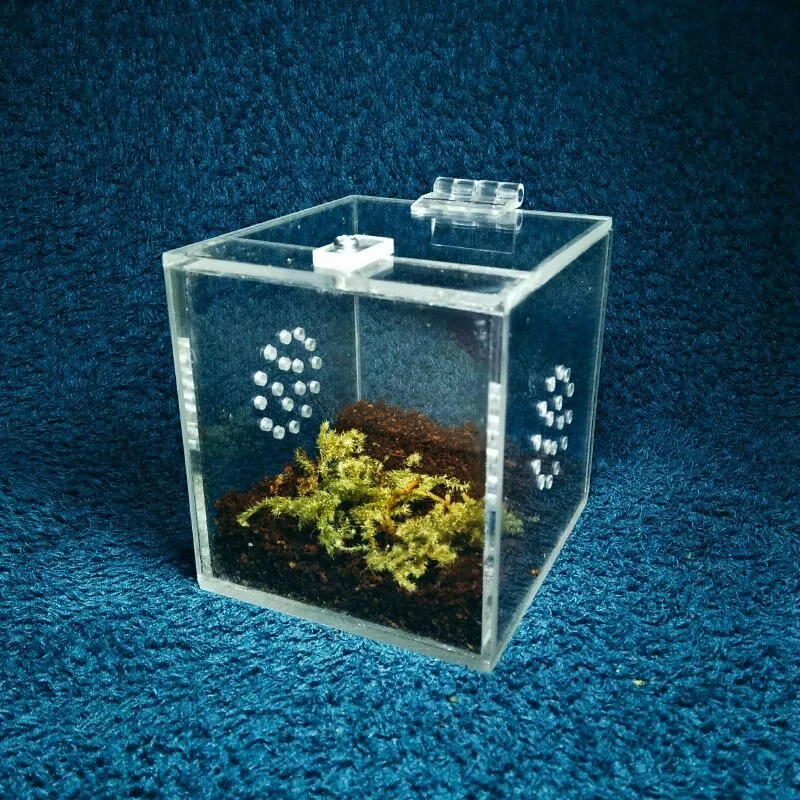
Ease of access is another important feature to consider when choosing a tarantula enclosure. You’ll need to access the enclosure regularly for feeding, watering, cleaning, and making any necessary adjustments. Look for enclosures with a top-opening or front-opening design, as these are generally the most convenient. Ensure that the opening mechanism is easy to use but also secure, preventing accidental escapes. Consider the size of the opening; it should be large enough for you to easily reach inside without disturbing the tarantula too much. A well-designed enclosure allows you to provide the necessary care to your tarantula with minimal stress for both you and your pet.
Secure Lids
A secure lid is a non-negotiable feature of any tarantula enclosure. Tarantulas are escape artists, and a poorly secured lid can lead to your pet wandering away, potentially putting it in harm’s way. Choose an enclosure with a lid that fits snugly and is difficult to open. Look for lids with secure locking mechanisms or clips. Regularly check the lid to ensure it remains securely in place. The security of the lid is crucial for preventing escapes and protecting your tarantula from external threats and environmental hazards. Investing in an enclosure with a secure lid provides peace of mind and ensures your tarantula’s safety.
Where to Buy Tarantula Enclosures on Shopee
Shopee is a popular online marketplace where you can find a wide selection of tarantula enclosures. Searching on Shopee can be a convenient and cost-effective way to acquire the necessary habitat for your tarantula. With numerous sellers offering various types of enclosures, you can easily compare prices, features, and read reviews from other buyers. By using the platform effectively, you can find the ideal enclosure that meets your specific requirements and budget. This approach can help to create a suitable environment that helps your tarantula to live happily.
Tips for Choosing a Shopee Seller
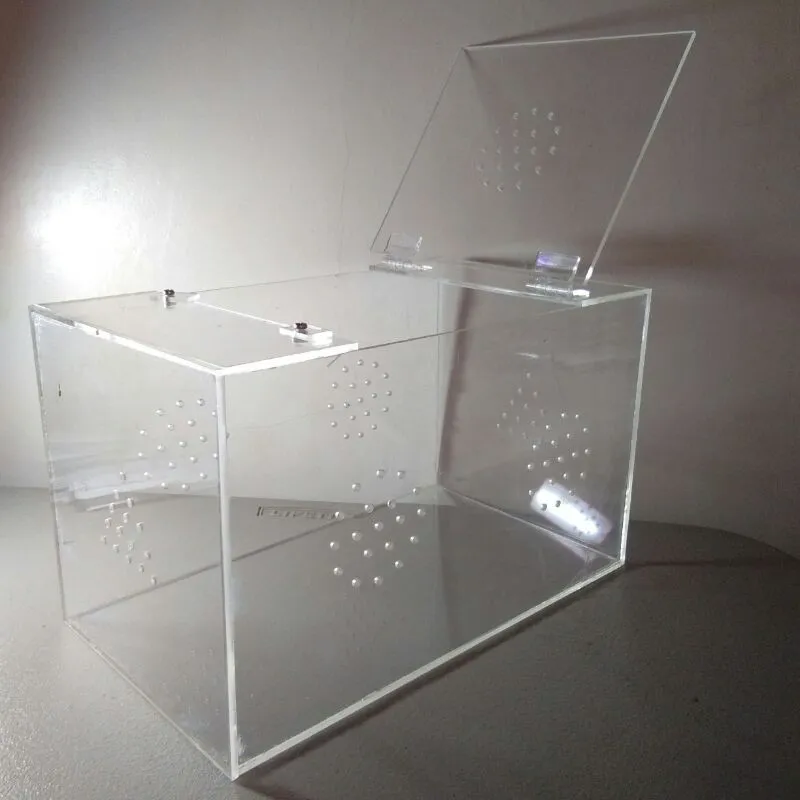
When purchasing a tarantula enclosure on Shopee, it’s important to choose a reputable seller to ensure you receive a high-quality product and a positive shopping experience. Always check the seller’s rating and read reviews from previous customers. Look for sellers with a high rating and a significant number of positive reviews, as this indicates that they provide good products and reliable service. Consider the seller’s response time to inquiries and their customer service policies. A seller who is responsive and willing to answer your questions is more likely to provide good support if you encounter any issues. Check the seller’s return and refund policies as a final point of consideration. A good seller should offer clear and fair policies to protect your purchase. This protects you, ensuring that your transaction is handled professionally and that you receive a quality tarantula enclosure.
Checking Reviews and Ratings
Customer reviews and ratings are valuable resources when shopping for tarantula enclosures on Shopee. They offer insights into the quality of the product, the reliability of the seller, and the overall shopping experience. Before making a purchase, carefully read customer reviews to understand the experiences of other buyers. Pay attention to comments about the enclosure’s quality, durability, and any potential issues. Check the seller’s rating to get an overview of their reputation. A high rating indicates that the seller has consistently provided good products and service. Use reviews and ratings to help you make an informed decision, increasing your chances of getting a great enclosure. This will provide the best habitat for your tarantula.
Shipping Considerations
Shipping considerations are an essential part of purchasing a tarantula enclosure on Shopee. Since enclosures can be bulky and fragile, it’s crucial to consider the shipping options and potential risks. Check the seller’s shipping policies, including the shipping costs, delivery time, and any insurance coverage. Make sure the seller uses appropriate packaging materials to protect the enclosure during transit. Look for sellers who have experience shipping similar items and have a good track record of delivering products safely. If possible, choose a shipping method that offers tracking so you can monitor the progress of your order. Be aware of potential delays due to the shipping process and plan accordingly. This will ensure your enclosure arrives in good condition.
Avoiding Common Mistakes
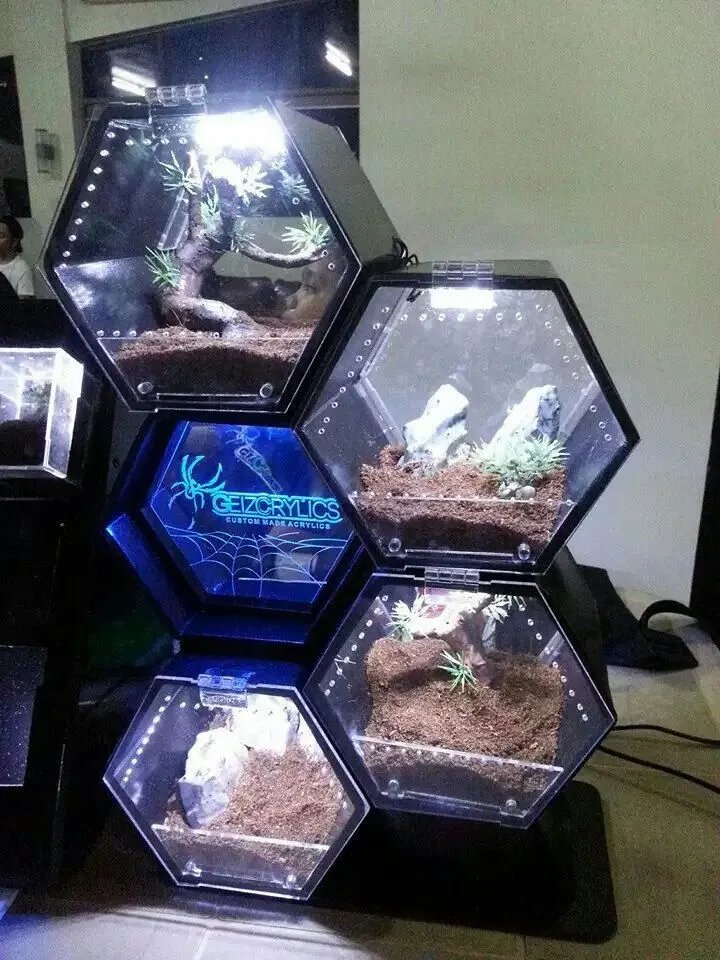
Even with the best intentions, tarantula keepers can make mistakes when setting up their enclosures. Being aware of these mistakes can help you avoid them and provide a safe and comfortable environment for your tarantula. By understanding common pitfalls, you can create the best possible habitat for your pet, leading to a healthy and rewarding experience for both you and your tarantula. Being informed is a critical part of responsible tarantula ownership.
Overcrowding
Overcrowding is a common mistake that can lead to stress, aggression, and even cannibalism in tarantulas. Avoid housing multiple tarantulas in the same enclosure, unless they are juveniles of a species known for communal behavior. Even in these cases, providing ample space is essential. Ensure that each tarantula has enough space to move around, hunt, and establish its own territory. Consider the adult size of the tarantula and choose an enclosure that is appropriately sized for its needs. Overcrowding can also make it more difficult to maintain proper environmental conditions, such as temperature and humidity. By giving your tarantula plenty of space, you can help it thrive and avoid unnecessary stress.
Poor Ventilation
Poor ventilation is a major problem that can lead to a variety of health issues for your tarantula. Inadequate ventilation can trap harmful gases, such as ammonia, within the enclosure, potentially causing respiratory problems. It can also lead to the buildup of excessive humidity, which promotes the growth of mold and bacteria. Ensure that your enclosure has sufficient ventilation holes, properly placed to allow for adequate airflow. The number and size of these holes should be appropriate for the size of the enclosure and the humidity needs of the tarantula species. Regularly monitor the enclosure’s humidity levels and adjust the ventilation as needed to maintain a healthy environment. Maintaining proper ventilation is an easy way to keep your tarantula healthy.
Inappropriate Substrate
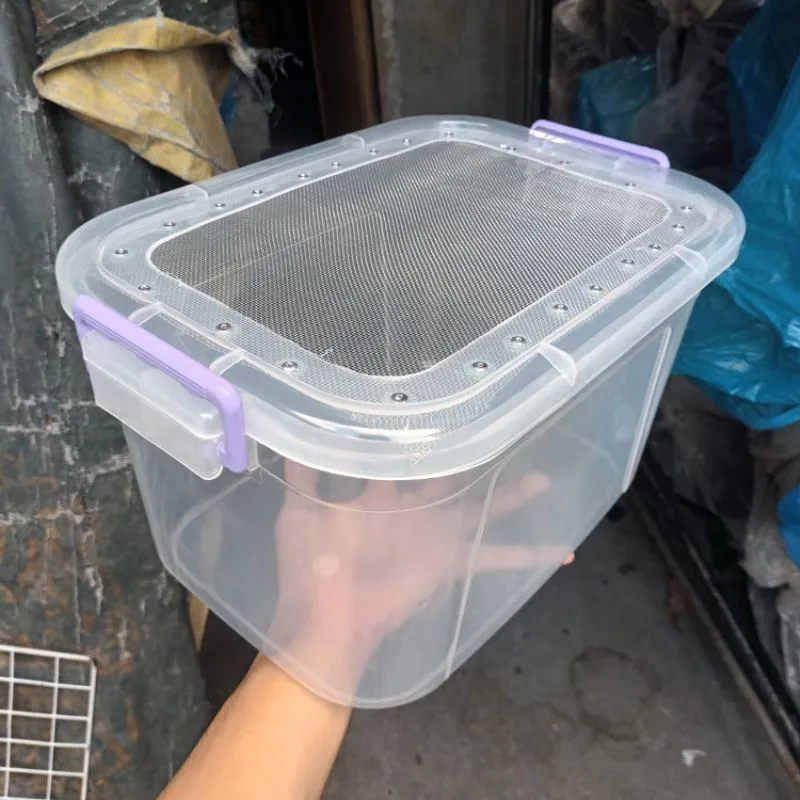
Choosing the wrong substrate can negatively impact your tarantula’s health and well-being. The substrate should be appropriate for the species and should meet its specific needs. For example, terrestrial species may benefit from a substrate that allows them to burrow, such as a mix of coconut fiber and peat moss. Arboreal species may require a substrate that retains more moisture, such as a combination of peat moss and sphagnum moss. Avoid substrates that are toxic or that can harbor mites or other pests. The substrate should also be easy to clean and maintain. By selecting the right substrate, you can create an environment that supports your tarantula’s natural behaviors and promotes its overall health.
